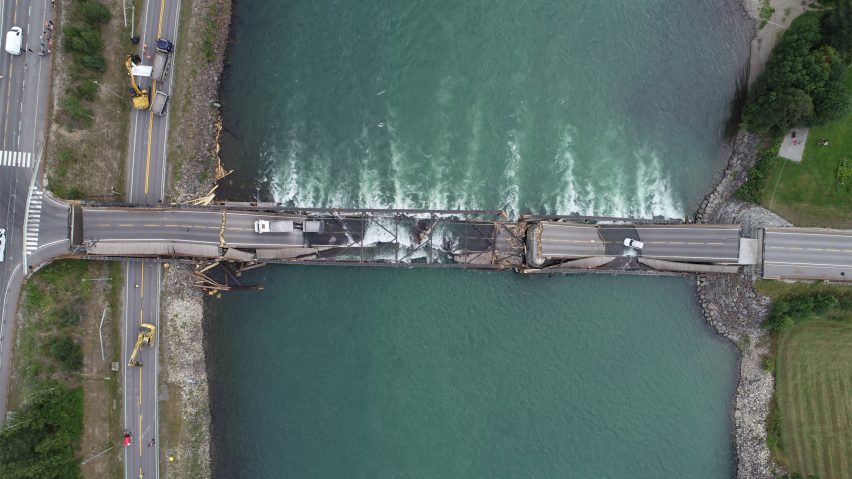An official report into the collapse of a 10-year-old mass-timber bridge in Norway in August 2022 has criticised the structure's design and construction.
Two drivers had to be rescued after the Tretten Bridge, over the Gudbrandsdalslågen river in the Øyer area of southern Norway, gave way as a heavy goods vehicle was crossing.
Completed in only 2012, the glulam-and-steel truss bridge was designed by Norwegian architecture studio Plan Arkitekter and engineering firm Norconsult for the Norwegian Public Roads Administration (NPRA).
A recent report by the Norwegian Safety Investigation Authority (NSIA) was critical of parties involved in the bridge's construction and management.
"The investigation has shown that inadequate caution was exercised in the planning, design, inspection and approval of Tretten Bridge, with respect to the risk factors linked to its unconventional design," the report said.
"A short construction period, span lengths and reuse of existing foundation were framework conditions for the planning of the bridge," it continued.
"These framework conditions, combined with the choice of material and a strong focus on aesthetics, contributed to the structure not being robust."
Failings over 2016 bridge collapse
An earlier report concluded that the bridge most likely collapsed as a result of block shear failure – a type of fracture – in one of its timber diagonal members that had become weak over time.
Tretten Bridge was designed while building regulations in Norway were in transition from a national system to European codes.
Provisions for this transitional period enabled the project to follow the older national standards, which unlike the Eurocodes did not account for block shear failure.
"In retrospect, all the involved parties can be criticised for selecting and accepting regulations that proved to have a serious shortcoming (block shear failure)," the NSIA said.
The report also dealt with investigations of Tretten Bridge carried out after the collapse of the similarly constructed Perkolo Bridge in 2016.
It found that despite "serious faults" being identified at Tretten Bridge around that time, little action was taken by the Norwegian roads authority.
"This represents a system failure in the NPRA, reflecting a lack of knowledge about block shear failure, as well as shortcomings in the bridge management system and risk management," the report said.
"The NSIA believes that Tretten Bridge should either immediately have been closed or traffic restrictions imposed in 2016 when finding over-utilisation in relation to block shear in several of the bridge's connections," it added.
Six safety recommendations have been issued based on the investigation, which the NSIA said provide lessons for relevant organisations in Norway and abroad.
These include reviewing the process for regulating and approving road-related structures and their materials in Norway and clarification of building regulations.
Tretten Bridge was 148 metres long and 10.5 metres wide, with a main span of 70 metres. A report produced by Plan Arkitekter and Norconsult in 2013 gave the bridge a life expectancy of 100 years.
"As far as the Accident Investigation Board is aware, there are no wooden and steel truss bridges in the world that are comparable to Tretten Bridge," said the NSIA report (translated from Norwegian).
"The bridge was special both in terms of span length and asymmetry, trusses in the same direction and the combination of wood and steel."
Aesthetics "not a governing topic"
The NPRA is currently undertaking steps to improve bridge safety. Four similar bridges to Tretten Bridge will reportedly be rebuilt following inspections carried out after its collapse.
Nine of 14 timber bridges that were closed following the incident remained shut or still had restrictions in place as of last month.
Plan Arkitetker has designed many of Norway's wooden bridges.
"If you read the conclusion from NSIA you will see that the collapse of the Tretten Bridge was caused by deficient regulations (national code) for building timber structures at the time of planning/construction," the studio's Yngve Aartun told Dezeen in a statement.
"When new regulations (Eurocode) in 2016 revealed a few critical weak joints nothing was done to improve these joints," he continued.
"The bridge had a normal time schedule for engineering and construction. The aesthetics was decided by structural and constructional considerations and not a governing topic to decide the structure in the planning process."
NPRA director general Ingrid Dahl Hovland said the authority is "well underway" with measures to address bridge safety.
"We are in the process of signing off on the first measures," she said. "We want to ensure that any nuances between the safety recommendations from NSIA and the package of measures are captured. This work has top priority."
Norconsult did not respond to a request for comment.
The photography is courtesy of the NSIA unless otherwise stated.

